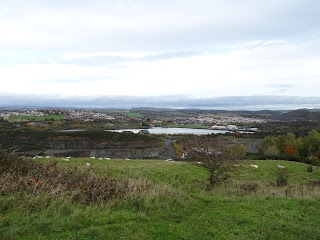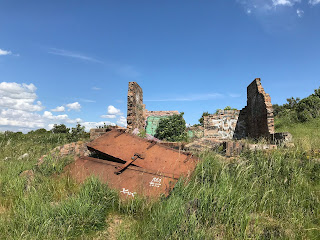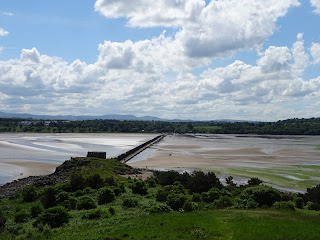If
you have ever driven across the old Forth Road Bridge to or from Fife, you will
have passed right by the Ferry Hills in North Queensferry. If you have ever taken a train over the Forth
Bridge, leaving from or arriving at any of the stations in Fife along from
North Queensferry, then you will have passed through the Ferry Hills. And it was off to the Ferry Hills that I
headed today.
The
hills are split by the train tracks, and I don’t think there is a path that
joins the two parts together. If there
is, well I’ve never found it. So, to start with I walked from the railway station
at North Queensferry up to the part of the hills that overlooks the two road
bridges. They both looked very bleak and
industrial in the cloudy grey, yet luminously bright winter sky.
After
taking a look at the bridges from a viewing point on the hill, I made my way up
to the top and had a wander around the marshy land there, where the Ferry Loch
sits. Other than a few tumbling down
stone walls and an old hut, there was nothing much there, just mud, long grass, and gorse bushes. It could have all been quite different though, as it is
rumoured that in the 13th Century a group of Jewish elders travelled
to Scotland to speak to King Alexander III.
They offered to buy the land at Ferry Hills and the coast below so that
they could build a town of refuge there.
However, Alexander had already promised the land to the town of
Inverkeithing, so turned down their request.
To think if he had agreed to sell the land, I may have been up there to
visit some historic synagogue and have a wander around that. Maybe then stop off at a deli for a smoked
salmon and cream cheese bagel and a piece of cheesecake, or a slice of challah with
a dollop of jam on it. And I wonder why I’m
overweight!
My feet muddy and my trouser legs wet, I made my way back down to the railway station and then up and around to the other side of the hill where, after a quick walk along a path covered in sheep shit, I found a memorial stone commemorating the last fatal duel fought in Fife.
The
story of this deadly encounter begins, and ends, in 1824. That year William Gurley, a Captain with the
Aberdeenshire Militia, had moved to Edinburgh with his wife and children. Being a typical gentleman of his time, Gurley
liked to bet on the horses, and in September of that year had gone to the races
at Doncaster. There he met up with an
acquaintance, John Waistell (or Westall).
At one of the races Waistell had lost a bet of seventy Guineas to Gurley,
and not having the money on him to pay, promised that he would do so on their
return to Edinburgh. However, back in
Edinburgh he did his best to avoid Gurley, leading Gurley to believe that he
was trying to get out of paying him.
Gurley, who was described by his friends as being a bit of a hot head at
the best of times and having quite a violent temper, did not take kindly to what
he saw as an affront to him by Waistell.
One day while out dining with his friend James Barr, Gurley decided they
should go to the Black Bull Inn, where Waistell was lodging, so that he could
confront him about his dishonourable behaviour and ask him to pay the money he
owed. So, they toddled off there. As you can probably imagine, it did not go
well. Words were exchanged with Gurley
calling Waistell a scoundrel and Waistell calling Gurley a liar, an insult
which made Gurley so mad he picked up a poker from the hearth and struck
Waistell across the neck and shoulders with it.
Waistell collapsed to the ground and Barr rushed to his aid, fearing
that Gurley might have killed him. Waistell
soon recovered though and the insults between the two men flew once more,
before Barr persuaded Gurley to leave.
After this there was much toing and froing between intermediaries from
Gurley trying to persuade Waistell to pay his debt. Waistell promised he would, but then either
found excuses not to, or on a couple of occasions wrote out promissory notes
that could not be cashed. Eventually
Gurley exploded with rage and a duel was agreed between the two men.
On
Saturday 30th October 1824, Gurley, and his seconds went to Salisbury
Crags in Edinburgh to meet Waistell to duel with pistols. He didn’t turn up. Gurley was not a happy man. But then a note arrived from Waistell giving
his apologies and stating that one of his seconds had been unable to make it
and this had caused his delay. It was
then agreed that given the time of day, the two men couldn’t duel in Edinburgh
as there would be too many people around, so it was decided they would make
their way to North Queensferry and duel there.
That
afternoon the two men and their seconds took the ferry over to North
Queensferry and found a secluded bit of ground on the Ferry Hills. There the seconds handed them their pistols
and it was agreed that ‘once, twice, thrice’ would be called and on ‘thrice’
they were to fire.
The
signal was given and Waistell fired. He
shot Gurley straight through the heart, and Gurley dropped to the ground dead
before he could even return fire. On
seeing that Gurley was dead, Waistell was so distraught that he put a pistol to
his own head and threatened to kill himself.
His friends managed to disarm him and quickly rushed him away from the
scene.
Gurley’s
body was taken to a nearby inn, and he was buried a few days later at St Peter’s
Churchyard in Inverkeithing. As for
Waistell, a warrant was issued for his arrest, but he disappeared and either
assumed a new identity or left the country, as he was never seen or heard from
again. So, there ends the sad tale of
the duel fought on Ferry Hills. If there
is any moral to this story then I suppose it is that betting is not good for
your health, and neither are hot tempers and guns.
I
left the Skulferatu that had accompanied me on my walk by a rabbit burrow near
to the memorial stone.
The
coordinates for the location of the Skulferatu are –
Latitude
56.016023
Longitude
-3.395713
what3words:
array.flows.national
I
used the following sources for information on Ferry Hills and the duel fought
by Gurley and Westall -
The Fringes of Fife
By John Geddie
1894
Inverkeithing, North Queensferry, Limekilns,
Charlestown, The Ferry Hills
Their Antiquities and Recreative Resources
Edited by Andrew Cunningham
1899
Scotland’s Penultimate Duel
J. M. Leggett
1998
The Scots Magazine - Wednesday 1 December 1824
Canmore – Ferry Hills













.jpg)
.jpg)
.jpg)
.JPG)

.JPG)
.JPG)
.JPG)
.JPG)
.jpg)
























